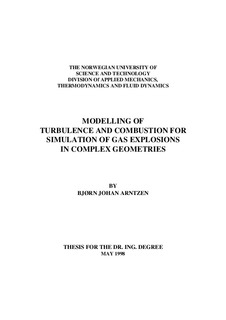| dc.description.abstract | This thesis analyses and presents new models for modelling of turbulent reactive flows for CFD simulation of gas explosions in complex geometries like offshore modules.
The most important aspects determining the course of a gas explosion in a complex geometry are the development of turbulence and the corresponding increase in the combustion rate during the explosion. To be able to model the process it is necessary to use a CFD code as a starting point, provided with a suitable turbulence and combustion model. The modelling and calculations are done in a 3D finite volume CFD code, where complex geometries are represented by a porosity concept, which gives porosity on the grid cell faces, depending on what is inside the cell.
The turbulent flow field is modelled with the k-ε turbulence model. The turbulent flow field behind obstructions, which should produce turbulence, is not resolved for smaller geometry. Subgrid models are therefore used for production of turbulence from geometry not fully resolved on the grid. Results from LDA measurements around obstructions in steady and transient turbulent flows have been analysed and the turbulence models have been improved to handle transient, subgrid and reactive flows.
The combustion is modelled with a burning velocity model, and a flame model which incorporates the burning velocity into the code. Two different flame models have been developed. SIF, which treats the flame as a interface between reactants and products, and the β-model where the reaction zone is resolved with about 3 grid cells.
The flame normally starts with a quasi laminar burning velocity, due to flame instabilities, modelled as function of flame radius and laminar burning velocity. As the flow field becomes turbulent, the flame uses a turbulent burning velocity model, based on experimental data presented by Bradley, as function of turbulence parameters and laminar burning velocity. The extrapolation of these data is evaluated. The laminar burning velocity is modelled as function of gas mixture, equivalence ratio, pressure and temperature in reactant.
Pressure/time curves from a range of hydrocarbon gas explosion experiments have been compared with simulations, which in most cases shows good agreement. In simulation of these experiments a range of parameters have been varied, as gas mixture, congestion, obstructions, confinement, scale and grid resolution. | nb_NO |
